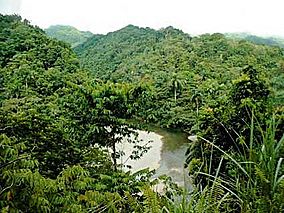Alejandro de Humboldt National Park facts for kids
Quick facts for kids Alejandro de Humboldt National Park |
|
|---|---|
|
IUCN Category II (National Park)
|
|

Alejandro de Humboldt National Park
|
|
| Location | Cuba |
| Nearest city | Guantánamo |
| Area | 711.38 km2 (274.67 sq mi) |
| Type: | Natural |
| Criteria: | ix, x |
| Designated: | 2001 (25th session) |
| Reference #: | 839rev |
| Region: | Latin America and the Caribbean |
The Alejandro de Humboldt National Park (which means "Alejandro de Humboldt National Park" in Spanish) is a special natural area in Cuba. It stretches across two Cuban provinces: Holguín and Guantánamo.
This park got its name from a famous German scientist, Alexander von Humboldt. He explored the island of Cuba way back in 1800 and 1801.
In 2001, UNESCO declared the park a World Heritage Site. This means it's a very important place for the whole world. It was chosen because it's large, has many different heights, unique rocks, varied landscapes, and lots of plants and animals found nowhere else.
Contents
Exploring the Park's Geography
Where is Alejandro de Humboldt National Park?
The park is home to some of the biggest rivers in the Caribbean islands. It's also known as the wettest place in Cuba. All this moisture helps create a huge variety of plants and animals.
The park covers about 711.38 km2 (274.67 sq mi) in total. Most of this is land, about 685.72 km2 (264.76 sq mi). The rest, about 22.63 km2 (8.74 sq mi), is ocean area. The land goes from sea level all the way up to 1,168 m (3,832 ft) at a peak called El Toldo.
What are the rocks like?
The area around the park has very interesting geology. It has karst landscapes, which are rocky areas shaped by water. These rocks formed from the ocean floor a long, long time ago. What's really special is that the rocks here are mostly "ultrabasic." This means they are made of certain minerals that are not common. The soil is often called "serpentine soil" and comes from rocks like "peridotite."
Amazing Wildlife of the Park
Why are there so many unique species?
During the Ice Ages, when much of the world was very cold, this area stayed warm. It acted like a "refugium," a safe place where plants and animals could survive. This helped many species continue to live here.
Also, the special "ultrabasic" rocks in the park can be a bit challenging for plants. This has caused plants to adapt quickly, leading to many new species. This is why the park has so many "endemic" species. Endemic means they are found only in this specific place and nowhere else on Earth.
Plants and animals you might see
The park protects 16 of Cuba's 28 plant species that are found only in Cuba. Some examples include the Dracaena cubensis and a type of Podocarpus tree.
You can also find many interesting animals here. There are different kinds of parrots, lizards, and hummingbirds. The park is also home to the endangered Cuban solenodon, a small mammal unique to Cuba. You might also spot hutia (rodents) and various types of snails.
Scientists have recorded over 900 different plant species in the park. There are also 45 types of reptiles, 21 types of amphibians, and 10 types of mammals.
A Home for Birds
The Alejandro de Humboldt National Park is known as an Important Bird Area (IBA). This means it's a crucial place for many bird species. It provides a safe home for both resident birds and those that migrate.
Many unique Cuban birds live here. Some examples include the bee hummingbird (the smallest bird in the world!), Cuban trogon (Cuba's national bird), and the Cuban amazon parrot. You can also find different kinds of woodpeckers, owls, and many other colorful birds.
History of the Park
Early Times
For a long time, people didn't use much of the land that is now the park. Only one ancient site from before Christopher Columbus arrived has been found here. It's located near the coast.
Later, in the 1700s and 1800s, some parts of the park were used as hiding places or camps by "maroons." These were people who had escaped slavery.
Becoming a National Park
The idea of protecting this area started in the 1960s. Two nature reserves, Jaguani and Cupeyal del Norte, were created. In the 1980s, another area called Ojito del Agua Refuge was proposed. This was because the very last Cuban ivory-billed woodpecker was seen there. This bird was already extinct in other places like the United States and Mexico.
In 1996, all these protected areas were joined together to form a national park. It was named after Alexander von Humboldt. Because of its amazing plants and animals, the park was declared a UNESCO World Natural Heritage Site in 2001. It is considered one of the most important natural areas in the Caribbean.
See also
 In Spanish: Parque nacional Alejandro de Humboldt para niños
In Spanish: Parque nacional Alejandro de Humboldt para niños


